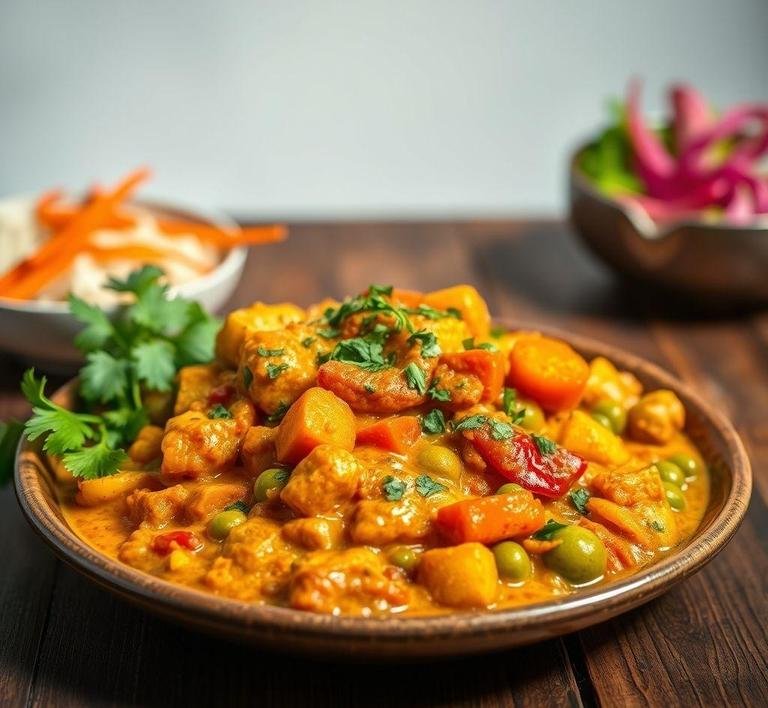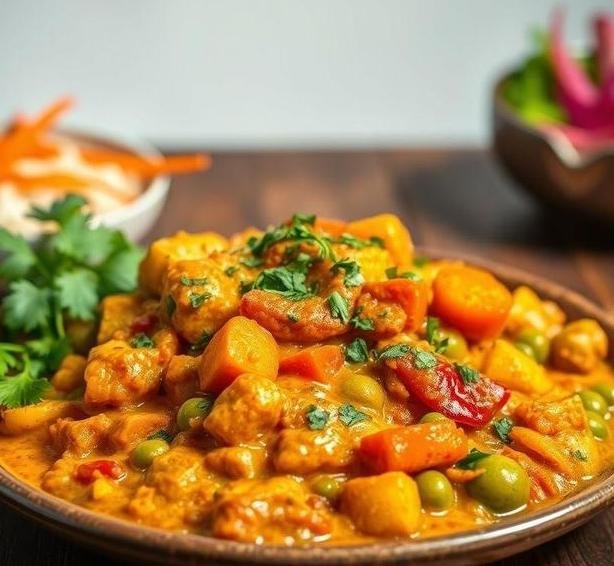Mary Berry’s Sabzi Vegetable Curry is a beautiful celebration of fresh, colorful vegetables simmered gently in a delicately spiced, richly flavored sauce. “Sabzi”, a word derived from Hindi and Urdu, simply means vegetables, but in the context of Indian cuisine, it typically refers to a comforting and aromatic vegetable dish, often dry or semi-dry, and sometimes cooked in a luscious curry base.
Mary Berry, known for her homely yet sophisticated approach to cooking, brings her signature British charm and simplicity to this Indian-inspired dish. Her version of Sabzi Curry doesn’t aim to replicate an authentic regional recipe in the strictest sense. Instead, it’s a thoughtful interpretation that balances accessibility with deeply satisfying flavors-ideal for weeknight dinners or relaxed weekend feasts.
This dish is vegetarian (and can easily be made vegan), gluten-free, and endlessly customizable. It’s hearty without being heavy and is perfect served with fluffy basmati rice, warm naan, or even a scoop of cooling yogurt on the side.
Mary Berry’s Sabzi Vegetable Curry Recipe
Ingredients Needed

Here’s a comprehensive list of what you’ll need to gather. While some ingredients are pantry staples, others might encourage you to explore the spice aisle or your local Indian grocery store.
Vegetables (core And Colorful)
- 1 large carrot, peeled and sliced
- 1 medium sweet potato, peeled and cubed
- 1 courgette (zucchini), sliced
- 1 red bell pepper, deseeded and chopped
- 1 small cauliflower, broken into florets
- A handful of green beans, trimmed and halved
- 100g baby spinach
For The Curry Sauce (the Soul Of The Dish)
- 1 onion, finely chopped
- 2 garlic cloves, minced
- 1 inch piece of fresh ginger, grated
- 1-2 green chilies (adjust to taste), finely chopped
- 1 tbsp tomato purée
- 400g can chopped tomatoes
- 200ml coconut milk (full fat for richness)
- 100ml vegetable stock
Spices (warming And Fragrant)
- 1 tsp cumin seeds
- 1 tsp ground coriander
- 1 tsp turmeric
- ½ tsp ground cinnamon
- ½ tsp chili powder (optional, for added heat)
- 1 tsp garam masala (added at the end for depth)
- Salt and black pepper, to taste
Optional Garnishes
- Fresh coriander (cilantro), chopped
- A squeeze of lemon or lime juice
- Toasted cashews or flaked almonds for crunch
Equipment Needed
You don’t need any fancy gadgets for this one-just a few trusty kitchen tools will do the trick:
- Large heavy-bottomed pot or deep sauté pan (non-stick or stainless steel)
- Chopping board and sharp knife
- Garlic press (optional, but helpful)
- Grater or microplane for the ginger
- Wooden spoon or heatproof spatula
- Measuring spoons
- Medium-sized bowl (for prepping vegetables)
- Saucepan (if cooking rice or side dishes simultaneously)
Instructions To Make Mary Berry’s Sabzi Vegetable Curry
Settle in and let’s walk through the steps together-it’s a relaxing, almost meditative process, and your kitchen will soon be filled with tantalizing aromas.
Step 1: Sauté The Aromatics
In your large pot, heat a splash of oil (sunflower or vegetable oil works well) over medium heat. Add the cumin seeds and let them sizzle for about 30 seconds until fragrant. Then toss in the chopped onion and cook gently for 5-7 minutes until soft and golden.
Step 2: Build The Flavor Base
Stir in the garlic, ginger, and chopped green chilies. Cook for another minute until everything smells vibrant and fragrant. Then add your tomato purée and stir for 1-2 minutes to deepen the flavor.
Step 3: Add Spices And Tomatoes
Sprinkle in the ground coriander, turmeric, cinnamon, and chili powder. Stir well to coat the onion mixture. Pour in the canned chopped tomatoes and let the mixture bubble gently for 5-10 minutes, stirring occasionally. The sauce should start to thicken slightly.
Step 4: Add Vegetables And Simmer
Add your hardier vegetables first-carrots, sweet potatoes, and cauliflower. Pour in the coconut milk and vegetable stock, season with salt and pepper, and stir gently to combine. Bring to a simmer, then cover and cook for 10 minutes.
Next, add in the quicker-cooking veggies: courgettes, green beans, and red pepper. Continue simmering for another 10-12 minutes, or until all the vegetables are tender but not mushy.
Step 5: Finish With Spinach And Garam Masala
Stir in the baby spinach and garam masala. The spinach will wilt in just a minute or two. Taste and adjust seasoning if needed-perhaps an extra pinch of salt, a dash of lemon juice, or a sprinkle more chili if you like it hot.
Step 6: Serve And Garnish
Ladle the curry into bowls or onto plates of rice. Sprinkle with fresh coriander and, if desired, a handful of toasted nuts or a swirl of yogurt. Serve hot with naan or flatbreads for a complete meal.
Tips And Tricks
Let’s make sure your Sabzi Curry turns out not just good-but phenomenal.
1. Cut Vegetables Evenly
This ensures they all cook at the same rate. You want tender vegetables with just a hint of bite-not a soft mess.
2. Layer Flavors Slowly
Don’t rush the base. Cooking onions low and slow is the secret to sweetness and depth, especially in a tomato-based curry.
3. Use Seasonal Vegetables
Feel free to swap ingredients! Butternut squash, mushrooms, peas, or aubergine (eggplant) all work beautifully depending on what’s fresh.
4. Make It Ahead
This curry tastes even better the next day as the flavors meld. It freezes well too-just leave out the spinach until reheating.
5. Adjust Spice Level To Taste
Mary’s recipe leans mild, but if you enjoy heat, feel free to up the chilies or add a touch of cayenne.
6. Add Protein If Desired
For a more filling dish, you can stir in cooked chickpeas, lentils, or paneer cubes during the final stages.
Mary Berry’s Sabzi Vegetable Curry is more than just a meal-it’s an invitation to explore a medley of vegetables wrapped in warm, spiced comfort. With each bite, you’re treated to a layered, thoughtful dish that’s both satisfying and healthy, making it perfect for vegetarians and curry lovers alike.
Whether you’re serving it for Meatless Monday, impressing guests at a dinner party, or simply indulging in a fragrant homemade dish after a long day, this curry fits the bill. It’s versatile, nourishing, and delightfully easy to make-even if you’re not a seasoned cook.
So roll up your sleeves, warm your spices, and let Mary Berry guide you into the delicious world of Sabzi Curry-you’ll be hooked from the first spoonful.
Easy Recipe Variations For Mary Berry’s Sabzi Vegetable Curry

Mary Berry’s Sabzi Vegetable Curry is a celebration of simplicity and spice-a hearty medley of vegetables simmered in a richly spiced tomato-based sauce. But what’s truly magical about it is how easily you can customize it to suit your pantry or personal taste preferences.
1. Swap the Veggies
While the original recipe typically features a colourful mix of cauliflower, carrots, peas, and potatoes, the curry welcomes creative swaps:
- Seasonal stars: In summer, try green beans, zucchini, or sweetcorn. In colder months, root vegetables like parsnips, turnips, or butternut squash add a cozy depth.
- Leafy greens: Stir in a handful of baby spinach or chopped kale towards the end of cooking. They wilt beautifully into the curry and boost the nutritional value.
- Legume lovers: Chickpeas or lentils (particularly red lentils) can transform this into a more protein-rich dish while maintaining its vegetarian integrity.
2. Adjust the Spice Levels
Mary Berry’s version is flavourful but usually quite mild-perfect for the whole family. However, if you crave heat:
- Add a finely chopped green chilli or a teaspoon of red chilli flakes while sautéing the onions.
- A spoonful of garam masala or a pinch of ground cinnamon at the end of cooking can enhance the curry’s warmth and complexity.
3. Make it Creamy
Want a richer curry? A swirl of coconut milk or a spoonful of Greek yogurt (added at the very end to avoid curdling) lends a luscious texture and mellow sweetness. This works especially well if you’ve added spicy elements.
4. Boost with Protein
To make this a complete meal or satisfy more substantial appetites, consider:
- Cubes of paneer, lightly pan-fried before being added in.
- Tofu, especially firm or extra-firm varieties, as a vegan alternative.
- Even cooked chicken breast or prawns, if you’re not strictly vegetarian.
5. Freshen it Up
Don’t underestimate the power of finishing touches. A scattering of fresh coriander, a squeeze of lime juice, or even a spoonful of mango chutney served on the side can brighten the dish and balance the spices.
Storing Leftovers
Sabzi Vegetable Curry is one of those dishes that actually improves over time as the flavours mingle and deepen. Here’s how to store it like a pro:
1. Refrigeration:
Let the curry cool completely before transferring it to an airtight container. It will stay fresh in the refrigerator for up to 4 days. When reheating, use a gentle heat to avoid breaking down the vegetables too much-either over low heat on the stovetop or in the microwave with a loose cover.
2. Freezing:
This curry freezes beautifully. Portion it into freezer-safe containers or resealable bags (pressing out as much air as possible). It will keep for up to 3 months. Defrost overnight in the fridge, then reheat as usual.
Pro Tip: If you’re planning to freeze the curry, slightly undercook the vegetables to preserve their texture. You can always cook them a little more when reheating.
What To Eat With Mary Berry’s Sabzi Vegetable Curry?
While the curry can stand tall on its own, serving it with a few accompaniments can elevate the entire meal into something truly special.
1. Rice
- Basmati rice is a classic, its delicate fragrance harmonising perfectly with the spices.
- For something heartier, try jeera rice (cumin rice) or brown rice for a nuttier bite.
- Coconut rice adds a tropical twist that pairs wonderfully with spicier versions of the curry.
2. Breads
- Naan bread, especially garlic naan or peshwari naan (with coconut and raisins), makes a delightful dipping companion.
- Chapati or roti offer a more traditional, lighter option.
- Even paratha, with its flaky layers, turns an ordinary meal into a feast.
3. Sides And Condiments
- A cool cucumber raita or mint yogurt sauce can offset the warmth of the curry.
- Pickled onions or a sharp achar (Indian pickle) bring tang and crunch.
- For more veggie goodness, serve with a simple kachumber salad-chopped cucumber, tomato, red onion, lime, and coriander.
4. Drinks:
Balance the spice with a chilled mango lassi, a refreshing coconut water, or even a glass of chilled white wine like a Riesling or Gewürztraminer.
Conclusion
Mary Berry’s Sabzi Vegetable Curry is more than just a recipe-it’s a canvas. A vibrant, wholesome dish brimming with textures, colours, and comforting spice. With just a few tweaks, it can become creamy and indulgent, fiery and bold, or light and zesty, depending on your mood and the contents of your fridge.
It stores well, feeds a crowd, and pairs effortlessly with so many sides. Whether you’re cooking for a quiet weeknight dinner or a lively weekend gathering, this curry adapts, evolves, and satisfies.
So next time you’re in the kitchen, don’t just follow the recipe-play with it. Spice it up, cool it down, dress it differently. And above all, enjoy every vibrant spoonful.
FAQs
What Vegetables Are Typically Used In Mary Berry’s Sabzi Vegetable Curry?
Mary Berry’s Sabzi Vegetable Curry typically features a variety of fresh, seasonal vegetables such as cauliflower, carrots, potatoes, peas, and spinach. You can also add bell peppers, courgettes (zucchini), or even sweet potatoes depending on what’s available. The mix of these vegetables creates a hearty, colorful curry that is both nutritious and full of flavor.
Can I Make Mary Berry’s Sabzi Vegetable Curry Vegetarian Or Vegan?
Yes, Mary Berry’s Sabzi Vegetable Curry is naturally vegetarian and can easily be made vegan by ensuring that no dairy ingredients are added. For instance, you can use coconut milk instead of cream or yogurt to maintain the creamy texture while keeping it plant-based. The recipe is flexible, so you can customize it to suit dietary preferences.
How Spicy Is Mary Berry’s Sabzi Vegetable Curry, And Can I Adjust The Spice Level?
Mary Berry’s Sabzi Vegetable Curry has a mild to medium level of spiciness, thanks to ingredients like cumin, coriander, and turmeric. However, the dish isn’t overwhelmingly hot. If you prefer a spicier curry, you can adjust the spice level by adding more chili, either fresh or in powder form. Alternatively, you can reduce the heat by using less chili and opting for a milder curry powder.


